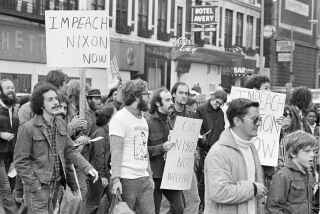Amorphous Middle Class Courted From Left, Right
- Share via
In championing the middle class, Sen. John F. Kerry follows a decades-long tradition of presidential challengers -- Democrat and Republican alike -- who have found the broad, vaguely defined category politically irresistible.
After all, with so many ways to measure the well-being of a group that covers as many as 90% of voting Americans, an argument can usually be made that things have gotten worse under the incumbent.
This year, the Democratic nominee has had a relatively easy time of it because there are numerous statistics and examples to support his claims of a “middle-class squeeze.”
Since 2000, when President Bush campaigned on his own “blueprint for the middle class,” family incomes have dropped while the number of Americans officially categorized as living in poverty has risen, according to Census Bureau figures released in late August. And the share of people earning $25,000 to $75,000 a year -- roughly the middle fifth of income earners -- has shrunk, with more leaving that group by moving down than up, the figures show.
“We used to be middle class. Now I’m not so sure,” said Veronica Chavez, 32, of Houston, who lost her job as an X-ray technician last year and hasn’t found comparable work since. These days, Chavez works part time at a department store while she studies to perform ultrasounds, a more promising occupation. Household income for her and her husband has dropped to $40,000 a year from $60,000, and a student loan adds to expenses.
“I’m not a political person,” she said, “but I remember when [President] Clinton was in office, there were a lot of jobs out there and they paid pretty well. Today, it’s very scary.”
Even those who have held their own have felt the stress of more costly healthcare, homeownership and higher education, all considered middle-class staples.
“I’m making more than I ever made before, but I feel like I have less buying power,” said Debbie Betts, a registered nurse and divorced mother of two in Milwaukee who earns about $70,000 a year. “You wouldn’t think it would be so hard, but with mortgages and taxes and insurance, it’s very, very hard to come out further ahead like you thought you would.”
Recent tax cuts promoted as a middle-class tonic haven’t made up the difference, some analysts say. In addition, according to the Office of Management and Budget, the cuts have had the effect of shifting more of the overall tax burden from the wealthiest to the middle.
Last week, the Economic Policy Institute, a liberal Washington-based research group, released a more detailed study of the middle. Researchers looked at the combined effect of changes in income, taxes and healthcare expenses for four demographic groups: married couples with children, elderly couples, single mothers and young single adults. The middle fifth of each group lost ground by as much as 4%, in inflation-adjusted dollars, in the last four years.
“Middle-income wage earners have not fared well under this administration,” said Economic Policy Institute economist Lawrence Mishel, who coauthored the report.
Census figures released in August -- showing that median household income dipped 3.4% from 2000 to 2003, hitting $43,318 -- were enough to convince the Annenberg Political Fact Check that Kerry’s middle-class rhetoric was right. The nonprofit monitoring group, which is operated by the Annenberg Public Policy Center of the University of Pennsylvania, was initially skeptical but now says on its website, factcheck.org: “While the decline leveled off last year and may even be climbing again in 2004, most households are clearly worse off economically now than they were when the president was sworn in.”
There is, of course, no shortage of disagreement with that assessment.
“The data is very complicated, and people can interpret it very differently,” said economist Chris Edwards of the libertarian Cato Institute in Washington. He said statistics such as median household income can be distorted by changing household sizes -- caused by divorce or other circumstances -- and shouldn’t be taken at face value. He also said the rising costs of healthcare, homes and education had been tempered by historically low interest rates.
What matters most, Edwards said, is that the economy is growing, thanks in part to the Bush tax cuts. “I think we’re in for another big boom in this decade, probably no matter who wins this election,” he said.
Kevin A. Hassett, economic director of the conservative American Enterprise Institute in Washington, offered a similarly optimistic take on the middle class, saying that as long as the gross domestic product grows, as it has been, the group is inevitably better off.
The proof is in consumption levels, he argued in a retort to the Kerry campaign claims last month. As measured by the federal Consumer Expenditure Survey, he said, the middle class spent about 2% more in 2002 than in the previous year. Consumption levels have increased steadily through the last two decades, Hassett said, adding, “That is hardly a squeeze.”
However, that spending has been subsidized by higher levels of personal debt, a trend that many economists view with alarm. And those who favor the shrinking-middle theory contend that much of the recent U.S. economic growth has gone into corporate profits rather than higher paychecks, exacerbating inequalities in wealth and income distribution. Data show that corporate earnings have risen much faster than wages.
Mishel of the Economic Policy Institute said polarization of income and wealth had been going on for decades. Other than a brief period in the late 1990s, when a booming economy lifted everyone’s fortunes, middle-class families have had to work harder to maintain a steady income, he said. More spouses have entered the workforce, adding child-care costs to the mix. And, he said, with higher debt and lower savings, families are less prepared to deal with emergencies than they were a generation ago.
Current trends don’t bode well for the middle class’ future. Seven out of 10 of the nation’s fastest-growing jobs are in the low-wage, low-benefit service sector, according to the Bureau of Labor Statistics. Global competitive pressures are forcing many employers to hold wages down. And weakened unions representing steel, auto, airline and supermarket workers, among others, have been forced to take concessions, either in immediate or future pay cuts.
Opinion polls suggest that at the very least, Americans believe that the economy is sputtering. Among likely voters interviewed by the Los Angeles Times in late October, 49% said the economy had worsened since 2000, versus 26% who said it had improved. Nearly one-fourth said it was about the same.
A week earlier, in a poll by Rasmussen Reports for Hudson Global Resources, 46% of working adults said the economy was getting worse, while 41% said it was getting better.
But people who believe they’re worse off don’t necessarily blame Bush or trust Kerry to make things better. The Rasmussen poll showed 47% of workers thought Bush would improve their personal finances, versus 41% for Kerry.
However squeezed middle-class voters may be, they are apparently more troubled by other issues. Recent polls consistently find the economy trumped by either national security, the Iraq war or social issues such as gun and abortion rights as voters’ top concerns for this election.
The great middle is split between Kerry and Bush along lines of gender, race, faith and geography. The Rasmussen poll even found marked differences between private sector workers (most favoring Bush) and government employees (most for Kerry), and between people who thought of themselves as entrepreneurs (most pro-Bush) or workers (most pro-Kerry).
All of which suggests that, at least in this election, the idea of a single cohesive middle class is fiction.
Historian Sarah McNeil Vosmeier, who teaches a course on the middle class at Hanover College in Indiana, said it had always been a slippery concept. Polls find that consistently, more Americans identify themselves as middle class than any other group, including working class. But ask them what it means, and the answer varies widely.
“Mostly it’s not clearly defined at all,” Vosmeier said. “Which is what makes it so appealing to politicians.”
*
(BEGIN TEXT OF INFOBOX)
Hurting the middle class
By many measures, middle-income Americans have lost ground since President Bush took office in 2001. The Economic Policy Institute found that the effect of changes in income, taxes and healthcare costs hurt the typical household in four demographic groups.
Average incomes, in real 2003 dollars, for the middle fifth of each demographic group
*--* Change, 2000-03 2000 2003 Dollars Pctg. Married couple with children Pretax income $69,023 $66,904 -$2,119 -3.1% After-tax income 55,130 55,047 -83 -0.2 After-tax and health 51,990 51,291 -699 -1.3 Single mother with children Pretax income 23,067 22,380 -686 -3.0 After-tax income 24,009 24,253 +245 +1.0 After-tax and health 21,595 21,162 -433 -2.0 Elderly couple Pretax income 36,828 36,474 -353 -1.0 After-tax income 33,988 33,527 -461 -1.4 After-tax and health 30,337 29,178 -1,158 -3.8 Single, ages 25-34 Pretax income 24,152 23,336 -816 -3.4 After-tax income 20,303 20,029 -275 -1.4 After-tax and health 19,582 19,228 -354 -1.8
*--*
Source: Economic Policy Institute
More to Read
Get the L.A. Times Politics newsletter
Deeply reported insights into legislation, politics and policy from Sacramento, Washington and beyond. In your inbox three times per week.
You may occasionally receive promotional content from the Los Angeles Times.










